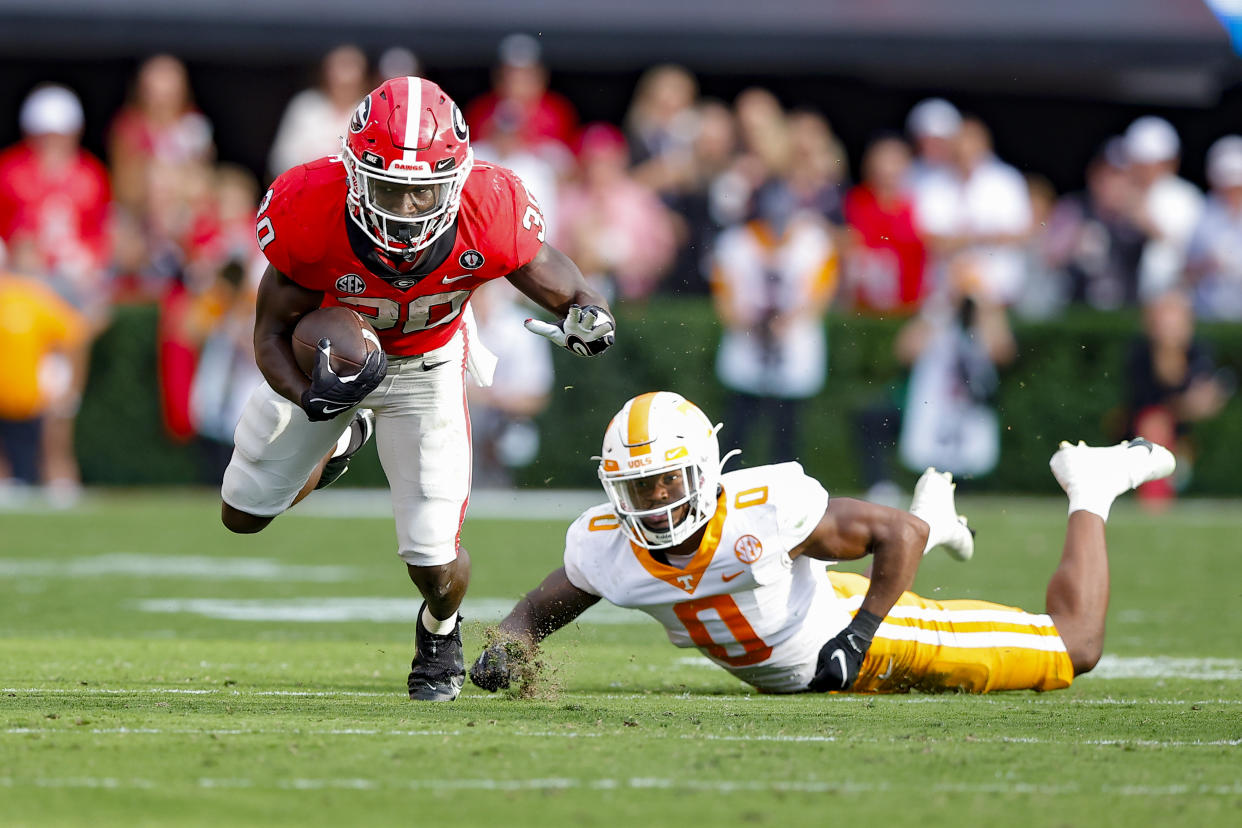Bold take time: Americans enjoy watching football. Like, a lot.
For all the pearl-clutching about how paying student-athletes would destroy the college game, for all the chest-pounding declarations that social justice messaging would crater the NFL, the numbers in 2022 tell a very different story. The farther we get from the generational disruption of the pandemic, the more it’s clear that American sports fans prize football over any other television option, much less any other sport, by a wide margin.
As groundbreaking statements go, “Americans love football” ranks somewhere between blinding, no-sh*t–Sherlock obvious and water-is-wet gospel truth. The degree of that love, though, is what will drive broadcast deals and entire calendars going forward.
The latest data point: Georgia’s Saturday afternoon decimation of Tennessee, which drew 13 million viewers, the most-watched college football game of the year. That beat every game of the World Series, including the clinching Game 6 later that night, which drew 12.5 million viewers. (The competing college football game, a tense LSU-Alabama matchup, drew 7.5 million viewers while on ESPN; the World Series was on broadcast TV.)
Baseball long ago gave up the fight against the NFL. As an expanded playoff looms on the horizon, the college version is now throwing its weight around, and the evidence is clear: even in the NIL era, when players are at last receiving above-board compensation, interest in the college game continues to skyrocket. There aren’t many truisms in broadcasting that have survived the streaming era, but there is this: live sports still rule, and football rules all live sports.
Baseball, golf surrender to football
Football’s dominance is so thorough that some other sports have decided the best option is to avoid competition entirely. Golf, for instance, has reworked its entire schedule so that its season ends on Labor Day weekend, before the NFL kicks off.
NASCAR, in contrast, continues to run its playoffs right in the teeth of the football season, competing on Saturday nights with college football and Sundays with the pro game. This past weekend’s championship race drew 3.2 million viewers, about the same as last season despite the national attention from Ross Chastain’s bold “Hail Melon” move the previous week. Although the race was broadcast on NBC, its finish went head-to-head with Tom Brady playing the Super Bowl champion Rams. Even one of NASCAR’s biggest names is conceding defeat.
"I don't see any reason in competing against NFL football when that starts,” Chase Elliott, NASCAR’s reigning Most Popular Driver, said in September. “In my opinion, that's not a battle we're ever going to win.”
Baseball finally threw the white flag earlier this year, deciding to play on Friday and Saturday and leave Sunday to the NFL. It marked the first time since the World Series began being broadcast in its entirety in 1947 that baseball surrendered Sunday night, but some fights you just can’t win.
(There was a time when the NFL halted its Sunday night programming to give the stage to baseball. That silliness stopped around 2010, when The Shield realized that willingly surrendering the most valuable broadcast real estate of the week was a foolish endeavor.)
The future looks even brighter … for football
Down the line, football’s hammerlock on the fall will only increase. An expanded 12-team playoff might cut into the numbers of a regular-season game like Georgia-Tennessee — both schools would be locks for a 12-team playoff this year — but adding eight (!) money-printing playoff games, all of which would average Georgia-Tennessee numbers, would more than offset any regular-season losses.
If there's a speed bump, it's this: the NFL’s Amazon numbers haven’t exactly lit the broadcast world on fire. After a strong start, the game has had difficulty breaking the 10 million viewer mark in recent weeks, and the low numbers are dragging the NFL’s ratings down as a whole. Through eight weeks, Sports Business Journal notes, the NFL averaged 15.7 million viewers per game, down from 16.5 million at the same point last year. (That 2021 figure was the NFL’s best through eight games since 2015, the last pre-protest season.)
The NFL is playing the long game with Amazon. Casual viewers and old-school NFL fans gripe about Amazon’s ever-increasing presence in the league — but then, there was a time when we never imagined streaming would replace going to Blockbuster and trying to find an available VCR tape of “Jurassic Park,” either. In three years’ time, going to Amazon for a football game will be as easy and familiar as going to Netflix for original movies now. Plus, the combination of viewers transitioning to a new format and some cringeworthy games (Chicago-Washington, Arizona-New Orleans) certainly hasn’t helped.
The mammoth football ratings are a Rorschach blot; you can take from them whatever you wish. Football in general, with its relative scarcity, horizontal format and pace of play, is perfectly engineered for casual viewers, fantasy players and betting. The NFL’s emphasis on The Shield Above All means that the outside drama that often consumes other leagues — hello, NBA — gets tamped down in favor of what happens on Sundays. (In the case of matters like Deshaun Watson or the Commanders’ nightmarish workplace, this isn’t a positive. It is, however, a fact.)
College football is now, for all intents and purposes, the NFL with a horn section and an unpaid labor force. The SEC mines areas underserved by pro franchises while the Big Ten monetizes traditional Midwestern football vibes. The college game plays on that most vulnerable and profitable of sensations — nostalgia, real or imagined — and appealing to the heart is a lot more lucrative than appealing to the mind.
Between them, the NFL and college football now own the weekend, and most of the week, for six months a year. Other sports, and other fans, face a stark choice: get out of the way, or settle for scraps.
______
Contact Jay Busbee at [email protected] or on Twitter at @jaybusbee.
Source: Read Full Article
